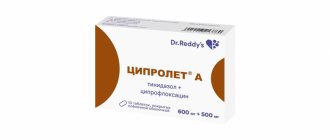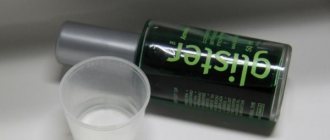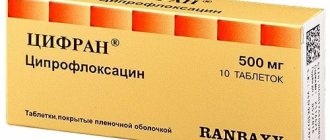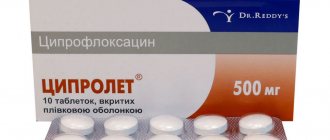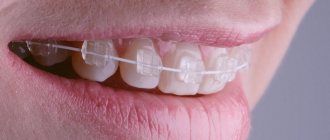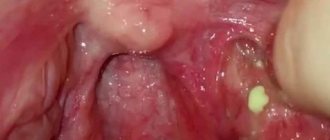Throughout his life, a person often encounters the negative effects of microbes on the body. Bacterial pathogens can settle on the skin, in the gastrointestinal tract, in the genitourinary organs and even on the conjunctiva of the eye. In such a situation, only a strong antibacterial agent will help cope with the infection. Most often, treatment begins with medications based on ciprofloxacin, so doctors often prescribe the antibiotic Tsiprolet to patients. Next we will talk about the beneficial properties of this medication.
Release form
Tsiprolet is produced by many pharmaceutical companies, as it is one of the most popular antibacterial agents. It is produced in the following dosage forms:
- infusion solution - in polyethylene bottles of 100 ml, where the content of ciprofloxacin does not exceed 2 mg per ml;
- tablets - each containing 250 mg or 500 mg of the main active ingredient, they are packaged in blisters of 10 pieces;
- eye drops - sold in bottles with a dropper of 5-10 ml, which contain 3 mg of ciprofloxacin per 1 ml of solution.
According to the instructions for use of Tsiprolet 500, these tablets contain the maximum dose of the active substance. They are used to treat severe bacterial lesions in advanced infections.
Tsifran or Tsiprolet which is cheaper
Tsifran and Tsiprolet are effective prescriptions against sore throat. In addition to ciprofloxacin, Cifran contains tinidazole; this combination enhances the effect against tonsillitis provocateurs. Prevents division and leads to the death of bacterial microorganisms. A common tablet form (recommended for angina) includes 500 mg of ciprofloxacin, the daily dose for an adult is 1000 mg (there are also 1000 mg tablets available, in which case 1 Cifran tablet is taken per day).
Comparing the prices for both products (Cifran 500 mg and Tsiprolet 500 mg), we come to the conclusion that the cost of the first is 2-3 times higher. However, the final decision on prescribing Tsiprolet, Tsifran or Augmentin depends on the attending physician and the results of preliminary diagnostics.
Mechanism of action of the drug
Tsiprolet belongs to the group of fluoroquinolones and is an antibacterial drug with a wide range of effects. Its main active ingredient is ciprofloxacin. This chemical compound has the ability to penetrate the DNA structure of the cells that cause the infection, thereby disrupting the vital functions of bacteria, their ability to subsequently reproduce and develop. The result of this influence is the death of harmful microorganisms.
Tsiprolet tablets have a complex effect, effectively destroying microbes that are both at the reproduction stage and in the resting phase. The spectrum of negative effects of this medicine extends to almost all types of gram-positive and gram-negative bacteria, most of the anaerobic pathogens. The instructions for use of Tsiprolet state that its main active component actively eliminates bacterial microflora that are resistant to other antibiotics, for example, the nitrofuran or sulfonamide series. Resistance of microbes to this medicine appears only after a long period of time.
Indications
Ciprofan tablets - what do they help with? This antibiotic is used for the treatment of complicated or uncomplicated bacterial infections that are caused by strains of microorganisms sensitive to ciprofloxacin. The remedy is indicated for the following diseases:
- urinary tract infections;
- bacterial lesions of the gastrointestinal tract;
- sepsis;
- pathologies of ENT organs, especially in case of infection with staphylococcal microflora and gram-negative bacteria, including the Pseudomonas type;
- peritonitis;
- infectious lesions of the respiratory system (for example, pneumonia), if they are caused by Enterobacter, Staphylococcus, Klebsiella, Haemophilus influenzae, Legionella or microbes of the Branhamella, Pseudomonas species;
- inflammatory infectious diseases of the genital organs in men and women (prostatitis, adnexitis);
- infections of the musculoskeletal system and skin;
- some sexually transmitted diseases (gonorrhea);
- bacterial lesions of the eyelid and conjunctiva of the eyes;
- therapy and prevention of infections in patients with low immunity (for example, with neutropenia or after treatment with immunosuppressive drugs).
Therapeutic tactics for tonsillitis
If we consider that chronic tonsillitis is only a long-term inflammatory process in the tonsils, then it is unlikely that this disease should have received so much attention from other medical specialties. Therefore, the very definition of tonsil disease as chronic tonsillitis requires clarification. This will make the motivation for different types of conservative or surgical treatment clearer. So, chronic tonsillitis is a process of constant interaction between lymphoid tissue and the contents of the lacunae of the palatine tonsils (purulent detritus with elements of foreign protein, toxins as a result of the vital activity of pathogenic flora, microorganisms themselves, dead epithelial cells from the walls of the lacunae of the palatine tonsils, nutritional particles). The discharge in the lacunae can be purulent, caseous, accumulate in narrow lacunae convoluted with spurs, and form so-called fetid plugs. This process, which takes place in the lacunae of the palatine tonsils, is under the control of the body until a certain time, i.e. There is constant active and passive drainage of tonsil lacunae along with the activity of macrophages, which, preventing inflammation of the palatine tonsil, contributes to the development of immunity to many microorganisms that enter the oral cavity and pharynx along with air and food.
This kind of balance between the vital activity of pathogenic active flora and the protective capabilities of the body can be disturbed for many reasons, as a result of which inflammation of varying intensity develops (it captures only the covering epithelium of the oral surface of the tonsils without its destruction), which passes to the epithelial cover of the lacunae of the tonsils with its destruction and formation necrotic plaques; suppuration of the tonsil follicles. Catarrhal, lacunar or follicular tonsillitis develops
.
In foreign literature, they tend to combine two diseases of the oropharynx and designate inflammation of the tonsils and pharyngeal mucosa as “tonsillopharyngitis.” However, experts in Russia quite reasonably believe that such a combination of two nosological units is possible only in cases of a combination of acute catarrhal pharyngitis and catarrhal tonsillitis. Lacunar and follicular tonsillitis have their own clearly defined clinical, morphological and microbiological aspects
, and they cannot be confused with manifestations of pharyngitis, especially from the point of view of the approach to treatment.
According to modern concepts, angina is an acute infectious-allergic disease, and it is necessary to approach the treatment of a patient with angina from this point of view.
As was said, the presence and persistent preservation of purulent detritus in the lacunae of the palatine tonsils is a determining factor both in making the diagnosis of “chronic tonsillitis” and in choosing the appropriate method of treatment - conservative or surgical.
A sore throat with destruction of the integumentary epithelium of the lacunae promotes the formation of scars in their lumen, which subsequently complicates the drainage of the lacunae of the tonsils. A kind of vicious circle arises - sore throat develops under the influence of pathogenic flora against the background of sensitization by a foreign protein due to a violation of the epithelial cover of the lacunae. Moreover, a sore throat can occur both under the influence of a pathogenic infection and as a result of nonspecific irritation (general hypothermia, drinking cold water).
Each previous angina, especially lacunar, follicular, can contribute to the development of conditions for relapse of inflammation, accompanied by otitis, sinusitis, and bronchitis.
The main reason for this is the viruses that cause most respiratory tract infections, which can weaken the body's defenses. Viruses reduce the ability of macrophages and granulocytes to absorb infectious agents. In this way, the epithelium of the mucous membrane is damaged, which impedes the activity of the epithelial villi and leads to stagnation of mucus. Weakening of local protective mechanisms in many cases leads to infection of the upper and lower respiratory tract with bacteria Haemophilus influenzae, Streptococcus pneumoniae and Staphilococcus aureus, which are usually found in the oral cavity and trachea.
The chronic nature of infections is an indicator that the body's immune system is unable to cope with its functions. Constant but insufficient activation of nonspecific defense mechanisms often causes an inflammatory response, but this is not enough to suppress infectious agents.
Undoubtedly, the nature of the pathogenic flora plays a big role in the occurrence of a particular sore throat,
but the background against which it occurs also influences the clinical picture of the disease. Therefore, therapy should be prescribed and carried out taking into account all identified features in each case (time from the onset of angina, age of the patient, frequency of exacerbations, concomitant diseases: general and from the ENT organs, clinical manifestations, including in the oropharynx, nature of the flora , previous treatment, its effectiveness).
Currently, much attention is paid to the role of group A streptococcus in the occurrence of acute tonsillitis and pharyngitis, although b-hemolytic streptococcus still occupies a leading position among bacterial pathogens. Thus, it is believed that in late autumn and spring it is group A streptococci that cause disease in 40% of children and 10% of adults. Along with this, there is an opinion that in the vast majority of cases, the incidence of the lymphadenoid ring of the pharynx in children is determined by a viral infection, the features of which are a protracted and recurrent course, insufficient effectiveness of conservative anti-inflammatory measures, and a tendency to hyperplasia of the palatine and pharyngeal tonsils. Usually, the doctor diagnoses a sore throat “by eye,” only on the basis of clinical experience, and prescribes antibacterial treatment without taking into account the advisability of antiviral therapy. This not only slows down the healing process, but can also contribute to a decrease in the protective properties of the pharyngeal mucosa, since under the influence of antibiotics a-hemolytic streptococcus, which produces bactericin, a natural antibiotic, disappears. It is penicillins
to a greater extent than cephalosporins, they suppress this beneficial flora of the oropharynx and allow pathogenic streptococci to take its place on the epithelium of both the tonsils and the entire pharynx. Therefore, irrational (too early and without taking into account the flora) prescription of antibiotics leads to a decrease in antibacterial immunity and contributes to relapses of sore throat.
Based on the foregoing, the treatment tactics for patients with acute and chronic tonsillitis should consist of an accurate determination of the nature of the inflammatory process (acute, exacerbation of chronic or its sluggish course), justification of the type of inflammation (catarrhal, purulent, phlegmonous), determination of the type of pathogen (streptococcus, spirochete, bacillus , virus, mushrooms). To this it is necessary to add that all sore throats can be divided into two groups
- primary tonsillitis, as a self-developing acute inflammatory process in the tonsils, and secondary tonsillitis, as a symptom of the underlying disease, for example, in blood diseases. Only the correct diagnosis, taking into account the general condition of the patient, determines the choice of treatment tactics.
Acute sore throat
Catarrhal tonsillitis is the mildest form of tonsillitis, which affects the mucous membrane of the tonsils, sometimes in combination with inflammation of the mucous membrane of the oropharynx (mainly the area of its posterior wall), which gives a mixed picture of tonsillitis and pharyngitis. The main complaint is pain when swallowing food and saliva (with pharyngitis, swallowing saliva is more painful - “empty swallow”). The general condition is satisfactory, the disease lasts 6-7 days, body temperature is within the subfebrile range. Treatment involves the widespread use of physiotherapeutic procedures, frequent rinsing with warm disinfectant solutions, a gentle diet, plenty of warm drinks, and the use of salicylates. Prescribing antibiotics for identified catarrhal tonsillitis is considered inappropriate, especially without a clear idea of the causative agent
.
Due to the fact that even without the use of antibiotics all the symptoms of the disease disappear quite quickly (on the 2-3rd day), early prescription of antibiotics in cases of catarrhal tonsillitis leads to the fact that patients stop taking them without observing the course dose. In addition, complete suppression, for example, by phenoxymethylpenicillin, amoxicillin (the most commonly used antibiotics), group A streptococci (and with them a-hemolytic streptococcus, which resists pathogenic flora) leads to the fact that the person returning to the normal environment (home, school and etc.) the recovered patient again encounters this flora, but already capable of transmission, i.e. the possibility of relapse of inflammation of the tonsils increases - natural immunity is suppressed. When prescribing antibiotics in the first days of a sore throat, it is also necessary to remember about the possible resistance of a number of strains of streptococci to the prescribed antibiotics, for example, to macrolides such as erythromycin, clarithromycin. Therefore, the most rational prescription of antibiotics in the treatment of mild forms of sore throat is after laboratory confirmation of the sensitivity of the flora to them
. These provisions are classics, but in practice, for many reasons, they are not always observed, which will ultimately lead humanity to complete disarmament in the face of transforming strains of pathogens, including those that cause sore throat.
Severe forms of angina - lacunar, follicular
- require the prescription of antibiotics, but also in compliance with the rules for combating infection and taking into account all factors: diagnosis, flora, somatic status, the need to prevent complications, the full course of taking an antibiotic.
Chronic tonsillitis
What are the treatment tactics for recurrent tonsillitis, recurring 2 times a year or more often?
In these cases, the disease is defined as “chronic tonsillitis,” however, for it, the frequency of relapses of tonsillitis may not always be the determining factor, since the concept of “chronic tonsillitis” also includes other parameters that support the diagnosis. These are, first of all, complications clearly associated with it from other organs and systems of the body.
For a practicing physician, both a general practitioner and an otorhinolaryngologist, after making a diagnosis of “chronic tonsillitis,” it is important to choose the tactics of treating the patient and decide the question: in which cases is surgery indicated, and in which - conservative therapy.
We divide chronic tonsillitis into only two forms: chronic tonsillitis I and chronic tonsillitis II
. In the first case, conservative treatment is required, in the second - surgical treatment. The determining factor is the combination of local signs of tonsillitis with complications and features of the course.
Conservative treatment
Conservative treatment involves, first of all, systematic sanitation of the lacunae of the palatine tonsils while preserving the lymphoid tissue of the tonsils.
as an immune, to a certain extent, organ. Conservative treatment is indicated for uncomplicated chronic tonsillitis in cases where surgery can be delayed due to the general condition of the patient; if the patient has not previously received any therapy or is mainly concerned about local manifestations of tonsillitis - purulent plugs in the tonsils, bad breath, etc.
Among the methods of conservative treatment for chronic tonsillitis, the most effective are the following: washing the lacunae of the tonsils and removing purulent plugs and detritus (carrying out repeated courses using the “Tonsilor” apparatus, when simultaneously washing the lacunae of the tonsils with a disinfectant solution, suctioning out the pathological contents from them and ultrasonic exposure with low-frequency ultrasound on the tonsil tissue), as well as the introduction of various medications into the tonsil using phonophoresis. Physiotherapeutic treatment – KUF, “Yakhont-F”.
Both for sore throat and for accompanying pharyngitis, gargling, inhalation, and irrigation of the mucous membrane with disinfectant solutions are indicated.
Increasing the effectiveness of treatment can be achieved by prescribing immunostimulating plant extracts. Tonsilgon N
is a combination preparation of plant origin. The chamomile, marshmallow and horsetail components included in its composition stimulate the body's defense mechanisms by increasing the phagocytic activity of macrophages and granulocytes. The drug has anti-inflammatory, immunostimulating, anti-edematous and antiviral effects, accelerates the healing process and shortens the duration of the disease; can be used in the future to prevent relapse of the disease. There were no side effects when using the drug.
Tonsilgon N is available in two forms: in the form of drops for oral administration and in the form of tablets. For adults, the drug is prescribed 25 drops or 2 tablets 5-6 times a day, for children under 5 years old - 5-10 drops, for children 5-10 years old - 15 drops, for teenagers 10-16 years old - 20 drops 5-6 times a day. day. After the disappearance of acute manifestations of the disease, the frequency of taking Tonsilgon N is reduced to 3 times a day. The duration of basic therapy is 4-6 weeks.
The prescription of systemic antibiotic therapy for uncomplicated forms of tonsillitis of non-streptococcal etiology is not always justified. In this case, local prescription of antimicrobial drugs is more rational (from the first day of the disease until the results of a microbiological study are obtained). The main requirements for local antibacterial agents are a wide spectrum of antimicrobial action, including the most typical pathogens, lack of absorption from the mucous membrane, and low allergenicity.
Fusafyungin (Bioparox) has the most optimal combination of the above requirements.
- inhaled antibiotic with anti-inflammatory properties. The wide spectrum of antibacterial action of fusafyungin, the absence of resistant strains of microorganisms, and the drug’s own anti-inflammatory properties make it especially effective in the treatment of tonsillitis of non-streptococcal etiology. The most optimal is to use 4 doses of the drug every 4 hours for 10 days.
Other drugs used in the treatment of sore throats and exacerbations of chronic tonsillitis are:
Clarithromycin
- 1 tablet 2 times a day.
Coldrex
- 2 tablets 2 times a day. Children 6-12 years old - 1 tablet 4 times a day.
Tonsillotren
(lozenges) - 1 tablet every hour.
Treatment of tonsillitis such as agranulocytic and monocytic requires the participation of a hematologist.
Surgery
Indications for surgical intervention:
1. Frequent (2-4 times a year) sore throats, accompanied by high body temperature; pathological purulent detritus is noted in the lacunae; there is one or another complication associated with an exacerbation of the process (polyarthritis, pyelonephritis, etc.).
2. Frequent sore throats (2-4 times a year or more often), accompanied by high body temperature, local signs of chronic tonsillitis are observed, without identified complications. Frequently recurring sore throats indicate a weakened immune system.
3. As a result of one of the rare cases of tonsillitis (once every 5-7 years), some complication of the heart, joints, etc. developed. Local signs of chronic tonsillitis, adenitis of the lymph nodes in the area of the angle of the lower jaw.
4. There were no cases of tonsillitis, however, against the background of emerging diseases of the heart, joints, etc., local signs of chronic tonsillitis are revealed, mainly the accumulation of purulent contents in the lacunae of the tonsils.
Fuzafyungin –
Bioparox (trade name)
(Servier)
Combined preparation of herbal origin –
Tonsilgon N (trade name)
(BIONORICA Arzneimittel GmbH)
| Applications to the article |
| Chronic tonsillitis is a process of constant interaction between lymphoid tissue and the contents of the lacunae of the palatine tonsils. |
| After making a diagnosis of chronic tonsillitis, it is important to choose a treatment strategy for the patient and decide the question: in which cases is surgery indicated, and in which - conservative therapy. |
Dosage and methods of application
The antibiotic Tsiprolet is prescribed by a doctor after examining the patient. The dose of the drug is selected based on the type of infection, the severity of the disease and the patient’s condition. The dosage regimen is also influenced by the functional ability of the urinary organs and the person’s body weight (when used in adolescence and childhood).
For the most severe cases of infection and when it is impossible to take the medication in tablet form, Tsiprolet is prescribed in the form of infusion solutions. Then the intravenous infusions of the drug are gradually stopped, and the patient switches to internal administration of the medication. The tablets do not need to be chewed; they simply need to be swallowed whole and washed down with a small amount of water. Take Tsiprolet, regardless of food intake, 500-750 mg twice a day.
The duration of therapy depends on the severity of the pathology and can vary from 3 to 21 days. Usually the doctor prescribes the use of this antibiotic for a period of 7 to 14 days.
Tsipromed or Tsiprolet which is better
Despite the identical active ingredient (ciprofloxacin), Tsipromed and Tsiprolet differ in their scope of application and release form. The first remedy is effective for eye diseases and pathologies of the hearing aid caused by a bacterial provocateur; Available in the form of drops with antibacterial properties. The second is effective for sore throat and tonsillitis of identical origin; it is produced in the form of tablets and liquid for injection.
Tsipromed is an effective prescription for otitis media accompanying bacterial tonsillitis. The use of ciprofloxacin-based ear drops can quickly relieve pain and inflammation of the middle ear cavity.
Like Tsiprolet, the medicine is not prescribed to pregnant women, nursing mothers, or children under 12 years of age. The cost of appointments is in one price category.
Adverse reactions and contraindications for use
Tsiprolet very rarely causes allergic reactions. After treatment with this medication, the following side effects most often develop: dyspeptic disorders, nausea and vomiting, skin itching and rash, shortness of breath.
The use of this medicine is contraindicated in the following cases:
- during pregnancy;
- if you are allergic to ciprofloxacin and quinolone drugs;
- in adolescence and childhood;
- during lactation.
Tsiprolet is prescribed with caution to elderly patients. The medication is used only in special cases for people suffering from epilepsy, vascular pathologies, and organic diseases of the brain. Such patients are more likely to experience side effects due to taking the drug, so this antibiotic is indicated for them only in life-threatening situations. In case of allergic reactions and other complaints (for example, joint pain, myalgia), use of the medicine should be discontinued.
Special information
Tsiprolet is not effective against streptococci, so it is not prescribed for the treatment of pathologies caused by bacteria of this group. In case of severe infection by anaerobes and staphylococcal microflora, it is better to take the medication in combination with other antibiotics, which will help enhance the therapeutic effect of ciprofloxacin.
The instructions for Tsiprolet tablets indicate that this drug can have an effect on the patient’s body, changing the ability to concentrate. Therefore, it should not be used by transport drivers and persons servicing complex mechanisms and machines. It is unacceptable to use the medication in combination with alcohol. Tsiprolet is available only with a doctor's prescription.
Tsiprolet or Augmentin - what to choose
Augmentin and Tsiprolet are effective for angina, but they belong to different pharmacological groups. For this reason, co-administration is unacceptable, as well as replacing one medication with another in the treatment protocol without medical permission. When prescribing a potent drug for tonsillitis, the doctor conducts a bacteriological culture to identify the resistance of the pathogen to antibiotics of the penicillin group, macrolides and cephalosporins. If the result is negative (means that the antibiotic is effective), Augmentin is prescribed along with Tsiprolet. When choosing between two medications, consider their positive and negative sides.
The advantages of Tsiprolet include:
- effectiveness against bacterial microorganisms resistant to penicillin antibiotics;
- minimal negative impact on the gastrointestinal tract;
- the use of Tsiprolet does not change the intestinal and vaginal microflora in women, does not cause dysbacteriosis, candidiasis and vaginosis;
- prolonged action of the drug (12 hours between doses);
- course duration is 5-7 days;
- low cost.
Cons of Tsiprolet:
- an extensive list of side effects;
- inadmissibility in the treatment of children under 15 years of age;
- Contraindicated for pregnant and lactating women.
In comparison with Tsiprolet, Augmentin is characterized by the following undeniable advantages:
- the synergy of the components (clavulanic acid and amoxicillin) helps quickly eliminate the provocateur of sore throat;
- the drug is approved for use by children from 3 months;
- with caution, but acceptable in the 2-3 trimester of pregnancy;
- the list of contraindications is much smaller.
The disadvantages of the medicine are:
- negative impact on the microflora of the stomach and genital organs;
- the cost is 2-3 times more expensive;
- Duration of therapy - from 7 days.
Based on the stated characteristics, we draw the following conclusions:
- Augmentin is preferable in the treatment of sore throat in children, older patients, expectant mothers, and patients who have no contraindications to penicillin therapy;
- Tsiprolet is recommended for adults and older patients with gastrointestinal pathologies and intolerance to antibiotics.
